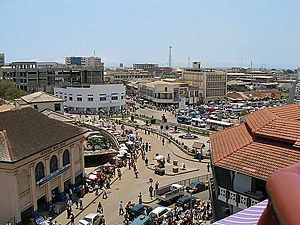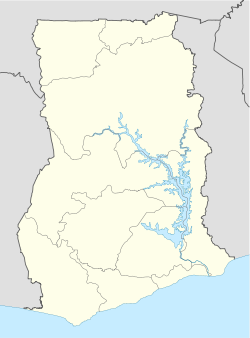Accra
| Accra | |
 |
|
 Accra
|
|
| Coordinates: | |
| District of Ghana | Accra Metropolis District |
|---|---|
| Government | |
| - Chief Executive | Stanley N. A. Blankson |
| Area | |
| - City | 185 km² (71.4 sq mi) |
| Elevation | 61 m (200 ft) |
| Population (2000) | |
| - City | 1,658,937 |
| - Metro | 2,905,726 |
| Time zone | GMT (UTC) |
| - Summer (DST) | Not used (UTC) |
| Website: http://www.ama.ghanadistricts.gov.gh/ | |
Accra is the capital, and most populous city of Ghana. The city also doubles as the capital of the Greater Accra Region, and of the Accra Metropolis District with which it is coterminous[1]. It is the administrative, communications, and economic center of the country. Over 70% of Ghana's manufacturing capacity is located within this region district. [2] Accra has been Ghana's capital since 1877, and contains public buildings reflecting its transition from a 19th century suburb of Victoriasborg to the modern metropolis it is today.
Among the attractions of Accra are the National Museum, with a display of exhibits that reflect the heritage of Ghana from prehistoric times to modern times, the National Theatre with its distinct modern architecture, Independence Square, the Kwame Nkrumah Mausoleum, the Accra International Conference Centre, the fishing port at Jamestown and Makola Market.
Contents |
History
Accra was founded by the Ga people in the late 1600s. The word Accra is derived from the word Nkran meaning "ants" in Akan, a reference to the numerous anthills seen in the countryside around Accra. During part of its history, Accra served as a centre for trade with the Portuguese, who built a fort in the town, followed by the Swedish, Dutch, French, British and Danish by the end of the seventeenth century.
The site of present-day Accra developed into a sizable town around the original Ga town as well as British, Danish and Dutch forts and their surrounding communities: Jamestown near the British fort, Osu near the Danish Christianborg fort (now Osu Castle) and Ussherstown near the Dutch Ussher fort. The four areas form the core of the modern city.
In 1877, at the end of the second Anglo-Asante War, Accra replaced Cape Coast as the capital of the British Gold Coast colony. After the completion of a railway to the mining and agricultural interior, Accra became the economic centre of Ghana. Large areas were destroyed by earthquakes in 1862 and 1939, but the city grew around a seaport (now relocated to Tema), and later a brewery, expanding into neighbouring towns.
The Accra Riots in 1948 launched the Ghanaian campaign for independence, which led to the Ghana's independence from the United Kingdom and nationhood in 1957.
Attractions

Accra is home to the National Museum of Ghana, the Ghana Academy of Arts and Sciences, the National Archives of Ghana, and Ghana's central library. Also of note is Christianborg or Osu Castle -- the residence of the president of Ghana, built by the Danes in the 17th century, the National Theatre, Accra Centre for National Culture, a lighthouse, the Ohene Djan Stadium, the Accra International Conference Centre, the W.E.B. DuBois Memorial Centre for Pan-African Culture and several beaches. Near the Parliament of Ghana is the Ghana-India Kofi Annan Centre of Excellence in ICT.
The Kwame Nkrumah Memorial is located in downtown Accra.
Osu is a neighborhood in the city known for its dining and nightlife options.
Climate
| Month | Jan | Feb | Mar | Apr | May | Jun | Jul | Aug | Sep | Oct | Nov | Dec | |
|---|---|---|---|---|---|---|---|---|---|---|---|---|---|
| Average high °F (°C) | 89.8 (32) |
90.9 (33) |
90.5 (33) |
90.0 (32) |
88.2 (31) |
84.7 (29) |
83.3 (28) |
82.4 (28) |
84.2 (29) |
86.9 (31) |
88.9 (32) |
89.1 (32) |
|
| Average low °F (°C) | 74.1 (23) |
75.4 (24) |
75.4 (24) |
75.6 (24) |
75.0 (24) |
73.6 (23) |
72.5 (23) |
72.0 (22) |
72.3 (22) |
75.0 (24) |
74.3 (23) |
74.1 (23) |
|
| Precipitation inches (mm) | 0.43 (10.9) |
0.86 (21.8) |
2.25 (57.1) |
3.81 (96.8) |
5.17 (131.2) |
8.7 (221.0) |
2.6 (66.0) |
1.1 (28.0) |
2.67 (67.8) |
2.46 (62.4) |
1.09 (27.7) |
0.63 (16.1) |
|
| Source: worldweather.org [3] 2008-01-05 | |||||||||||||
Education

On the outskirts of Accra are two popular secondary schools namely Achimota Secondary School; commonly referred to as "Motown", which was founded in 1924 and opened in 1927, and the Presbyterian Boys' Secondary; commonly known as "Presec".
In the vicinity of these two secondary schools is Ghana's first tertiary institution, the University of Ghana. It is located and 13 km north at Legon. Quite recently, another tertiary institution - Ashesi University - was established in Accra. Ghana International School (GIS), a private non-profit A-Level school founded in 1955 for children from ages 3-18 is located in Cantonments, Accra. Abelemkpe is the home of Lincoln Community School, Accra Ghana (LCS). LCS is also a private, non-profit International Baccalaureate school for students aged 3-18, and was established in 1968.
Transport
Accra is a major transport hub, home to the Kotoka International Airport and lies on railway lines to Tema, Takoradi and Kumasi. The main harbour city, Tema is connected through one of Ghana's highways.
Public transit in the city is provided by a mix of privately owned mini-buses (known as Tro-Tros), taxis and state-owned buses. Tro-Tros are usually converted Mini-buses that run a regular, well-known route. They are cheap and frequent but often in poor repair and over-crowded. In 2002, the city introduced metro bus services, which were initially met with skepticism by commuters, but have increased in popularity.
Sister Cities
Gallery
References
- ↑ http://www.ghanadistricts.com/districts/?news&r=1&_=3
- ↑ 'Formal Economy'
- ↑ World Weather Information Service - Accra
External links
- Latest Accra News
- Map of Accra
- Google Earth image of Accra, Ghana
- Ghana-pedia.org - Greater Accra Region
| Akan states of Gold Coast | |
|---|---|
| Accra (Ga) | Efutu | Akyem (Bosome, Abuakwa, Kotoku) | Adanse | Akuapem | Akwamu | Asen | Mankessim (Fante) | Dwabena | Gyaaman (Abron) | Bono | Denkyira | Asanteman (Twi) | |
|
|||||
|
|||||
|
||||||||